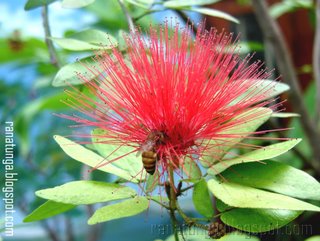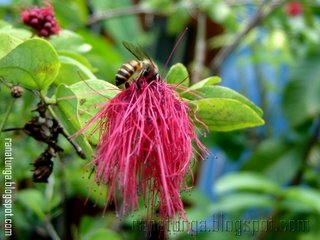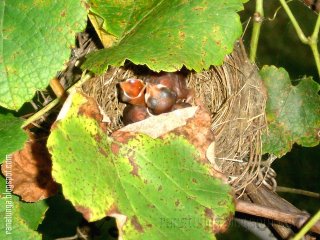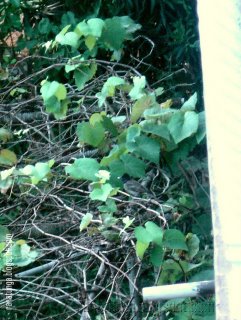

Earth tremors have been felt in some areas of Sri Lanka, including Colombo & Kandy. The images here are from USGS Earthquake Hazards Program.
According to USGS,
Magnitude: 5.2
Time: at 04:27:28 (UTC)
at 10:27:28 am local time at epicenter
at 09:57:28 am Colombo, Sri Lanka
Location: 6.548°N, 84.455°E (In bay of Bengal)
Distance: 510 km (315 miles) E of Colombo, Sri Lanka
More details visit here Magnitude 5.2 - BAY OF BENGAL
I couldn't find any details regarding any Tsunami Warnings at the time of posting.
The relevant links are:
2007-07-18
Earthquake near Sri Lanka!!!
Posted by PRan at 7/18/2007 11:47:00 am 2 comments
Labels: Disaster, Facts, Nature, Sri Lankan
2007-05-31
Once in a Blue Moon
Blue Moon, has nothing to do with it's colour. It only means, a full moon that occurs for the second time in a month. Considering that the average interval between two full moons is about 29.5 days & a month has about 30.5 days, it's a rare occurrence to have two full moons in a month. But it occurs about 41 times in a century or only occurs once in about 32 months.
The term 'Once in a Blue Moon' has been in use in medieval England from old times & one such occasion was in a 'Treatyse of the Buryall of the Masse' by William Barlow, the Bishop of Chichester, in 1528.
But the usage of this phrase had had different meanings during these long years of use,
- in 16th century: obvious absurdities, where there could be no doubt.
- in 18th century: as equal to 'never'
- in mid 19th century: a fairly infrequent event
But this year Americans have seemed to have celebrated the Blue Moon on 31st of May, 2007. >>> Blue Moon over North America on Thursday. How can that be? How can they have a Blue Moon two month before New Zelander's had one?
| Time Zone | City | Full Moon 1 | Full Moon 2 | Full Moon 3 | Full Moon 4 |
| GMT + 12hrs | Auckland | 2 May @ 22:09 | 1 June @ 13:04 | 1 July @ 01:49 | 30 July @ 12:48 |
| GMT + 04hrs | Moscow | 2 May @ 14:09 | 1 June @ 05:04 | 30 June @ 17:49 | 30 July @ 04:48 |
| GMT | Greenwich | 2 May @ 10:09 | 1 June @ 01:04 | 30 June @ 13:49 | 30 July @ 00:48 |
| GMT - 05hrs | Chicago | 2 May @ 05:09 | 31 May @ 20:04 | 30 June @ 08:49 | 29 July @ 19:48 |
For more details go to The Blue Moon of 2007.
It seems the method used for calculating the blue moon astronomically also had not been the one used earlier. This new definition had come into use after it had been mistakenly interpreted by an amateur astronomer in an article in 1946 in Sky & Telescope magazine on Blue Moons (see What's a Blue Moon?). It had then been adopted by various other newspapers, radio & TV shows giving wide publicity to this misinterpretation.
The correct definition had been a complex one, that uses seasons rather than months to calculate the blue moon. The third full moon occurring in a season with 4 full moons had been considered to be the blue moon (Usually a season only had three full moons). But it had not been so simple either.
The year they used was 'tropical year' running from one winter solstice to the next. The seasons were defined using a method which gives seasons of equal duration (which uses dynamical mean Sun or fictitious mean Sun, which are imaginary bodies & this method is not used now to define seasons). Then also they used some rules which are laid down in Gregorian calendar reform in 1582.
To see a list of blue moons according to this old definition visit Blue Moon - four Full Moons in a season. According to this it seems there is no Blue Moon in 2007. Phew... after all I'm not doing blog posts Once in a Blue Moon.
references:
- The Phrase Finder: Once in a blue moon
- Science @ Nasa: Once in a Blue Moon
- Obliquity: Once in a Blue Moon
Posted by PRan at 5/31/2007 08:10:00 pm 0 comments
Labels: Facts, Nature, Photography
2007-03-28
Woodpecker's headache!
 These are a couple of Red backed Woodpeckers or Black-Rumped Flamebacks (Dinopium benghalense) I saw in my backyard. I got their attention because of the characteristic hammering sound they generate while searching for insects in tree barks.
These are a couple of Red backed Woodpeckers or Black-Rumped Flamebacks (Dinopium benghalense) I saw in my backyard. I got their attention because of the characteristic hammering sound they generate while searching for insects in tree barks.When I did a web search, I found some amazing evolutionary adaptations they have for their niche.
They hammer 10 times a second up to 5 hours & creates a force of 30G (30 times the force of gravity) when the beak hits the tree bark.
- beak is stronger than steel with a chisel like tip
- neck muscles highly developed for hammering
- skull is relatively thick with relatively spongy bone to cushion the brain
- bones between skull & beak are joined by flexible cartilage, which cushions the shock
- relatively less cerebrospinal fluid around brain & relatively small brain, less prone to concussion
- contracts mandibular muscles just before impact, transmitting the shock to whole body passing the brain
Posted by PRan at 3/28/2007 10:02:00 pm 3 comments
Labels: Facts, Nature, Photography, Sri Lankan
2006-12-27
Tsunami remembrance...
Immediately after this great catastrophe in 2004, most of the staff members (including specialist consultants) from all government hospitals were mobilized to conduct health camps in the affected areas.
Below are some of the photos I took at Sainthamaruthu Hospital in Ampara District after it was destroyed by Tsunami waves.


Posted by PRan at 12/27/2006 12:15:00 am 3 comments
Labels: Disaster, Nature, Photography, Sri Lankan, Tsunami
2006-10-02
Busy Bees...
Today morning I saw these bees busy at work. Got some really beautiful photos of them.
I just thought of reading more on them & found some very interesting facts...
Posted by PRan at 10/02/2006 10:08:00 pm 3 comments
Labels: Facts, Nature, Photography, Sri Lankan
2006-08-20
Kandyan Dancer Orchid
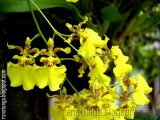
 These are Kandyan Dancer Orchids from our garden. This belongs to the genus Onicidium, which has more than 300 orchid species.
These are Kandyan Dancer Orchids from our garden. This belongs to the genus Onicidium, which has more than 300 orchid species.
I could not find the exact species name of this orchid though.
These have been named after it's resemblance to Kandyan Dancers, a traditional form of upcountry dancing in Sri Lanka, where the dancers wear highly ornamented costumes. < Kandyan Dancers in the Procession on my Wedding day
< Kandyan Dancers in the Procession on my Wedding day
Also visit Oncidium to read more on this genus of Orchids
Posted by PRan at 8/20/2006 08:51:00 pm 9 comments
Labels: Nature, Photography, Sri Lankan
2006-05-19
Lethal Prayer - let this prayer be ignored...
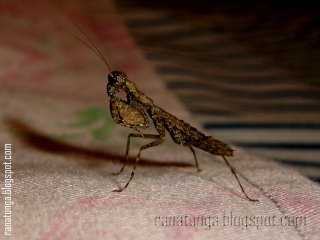
It feeds on other mantises, Insects such as butterflies, beetles, grasshoppers, flies & crickets. At the bottom of this post there is a link where you can see pictures of a mantis that has caught a hummingbird. It uses it's fore limbs equipped with razor sharp spines to deliver a fatal blow that will penetrate it's prey & it quickly bites the neck of the prey before starting to eat.
The one I saw was brownish in colour & they vary from Green to Pink & flower mantises are magnificently beautiful with flower like appearance. This is essential to it for it's survival as there are so many predators such as Birds & spiders that feed on them. Also Mantises use their camouflage to catch their prey, as unwary victims pass-by without noticing it.
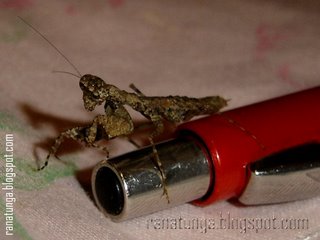 The specimen I found was a very small one, where I have taken a picture of it with a pen for size comparison.
The specimen I found was a very small one, where I have taken a picture of it with a pen for size comparison. Posted by PRan at 5/19/2006 10:59:00 pm 3 comments
Labels: Nature, Photography, Sri Lankan
2006-02-14
The culprit
After the Bulbul family left the nest, I removed the tar sheets covering the nest. I thought the predator bird would return (see Tragedy...) if it saw the nest & I didn't had to wait long to get results. It came right to the nest & was searching all over.
It was a magnificent bird with grey-blue coloured body & was very fast. I only managed to capture it's photo after it flew away to a distant tree.
This was a Shikra ('kurulugoya' in sinhala). A magnificently beautiful bird.
The scientific name is Accipiter badius.
It's a bird of prey. It's a small bird with short broad wings & long tail. It's found in South Asia & sub-Saharan Africa. It's prey include lizards, dragonflies, small birds & mammals.
Further readings:
Also see my other post on Bulbul nest:
Posted by PRan at 2/14/2006 10:56:00 pm 1 comments
Labels: Facts, Nature, Photography, Sri Lankan
2006-02-12
Flying lessons

Bulbul parent showing how to fly
The bulbul parents were bringing food near & would take it away compelling the birdling to come out of the nest & it jumped out of the nest readily. I always stayed around, as I did not wanted it to end in our cats stomach. It seems they didn't mind me sitting around. Even I examined the birdling for injuries few times when it fell from above during the process.
It was a nice thing to see. The parents brought food near it & flew away as birdling approached. Parents flapped wings to show the young one how to fly. Soon the small one started flapping wings & off it went few yards. I was amazed to see it & was very happy too. After few more flights, three of them flew away to distant.
Then only I felt sad, as I missed them...
To read from the bigining please read,
Posted by PRan at 2/12/2006 11:52:00 pm 1 comments
Labels: Nature, Photography, Sri Lankan
2006-02-10
Tragedy...
I was watching a cricket match when I heard the screams of the Bulbuls. I thought it was a cat who had attacked their nest & I went quickly to see whats happening. I saw a large bird fly away & it dropped something & it was one from the nest. I was there in time to save only one bulbul birdling.I returned it to the nest.
Other two birdlings were not to be seen. May be the predator bird had had them. I could not see the predator bird as it flew away. But it is sure to return. So I placed two tar-sheets over the nest & Bulbul parent could get into the nest from the side.
The Bulbul parents were watching from a distance. They did not return to the nest even at that nite. But next day morning it flew away as I came near the nest. During past few weeks the bulbul parents were so acoustemed to us, we could go near them without alarming them. But now because of this incidence they even seem to suspect us.
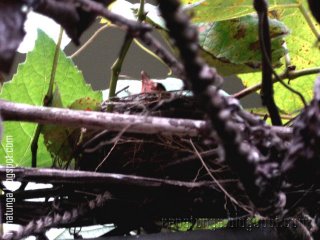 |
Birdling alone in nest (seen from below) |
 |
| The only survived birdling in the nest, alone at night |
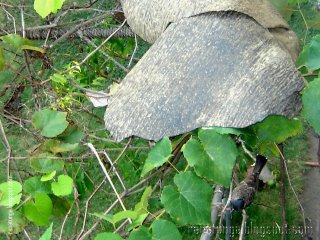 |
| Tar coat on top of the nest. Bulbul parent also seen coming out of the nest |
Posted by PRan at 2/10/2006 10:47:00 pm 1 comments
Labels: Disaster, Nature, Photography, Sri Lankan
2006-02-04
Red vented Bulbul
Posted by PRan at 2/04/2006 09:37:00 pm 0 comments
Labels: Facts, Nature, Photography, Sri Lankan
2006-02-03
New life...
Posted by PRan at 2/03/2006 09:08:00 pm 0 comments
Labels: Nature, Photography, Sri Lankan
2006-01-15
Glorious flower in the Garden
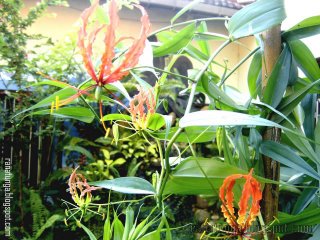 This is a bunch of Glori Lilies, also known as Flame Lily, Climbing lily & Gloriosa Lily, I found in our garden. This plant is a creeper & the tips of the leaves wrap around substrates. The scientific name is Gloriosa superba.
This is a bunch of Glori Lilies, also known as Flame Lily, Climbing lily & Gloriosa Lily, I found in our garden. This plant is a creeper & the tips of the leaves wrap around substrates. The scientific name is Gloriosa superba.Even though the flowers are very beautiful, all parts of this flowering plant are toxic. The tubers are the most toxic part. The toxicity is mainly due to alkaloid Colchicine. The lethal dose varies from 6mg to 20mg.
- Abdominal pain,
- Nausea & Vomiting
- Diarrhoea
- Bleeding manifestations (after 24hrs)
- Confusion, Convulsions & Coma
Management of the poisoning,
- Gastric Lavage,
- Multiple doses of Activated Charcoal,
- Correction of other complications such correcting dehydration & shock, correcting electrolyte imbalances
- Assisted ventilation if necessary
- Forced Diuresis within first 24hrs
(Reference: Ravindra Fernando (2002) Management of Poisoning, 2nd revised Ed. The National Poison Information Centre, NHSL, Colombo, pp 114-116.)
Some information on this plant can be found at,
A detailed description of the poison Colchicine can be found at IPCS INCHEM
Puah had published a nice poem on this flower. Please read it too >> L'chaim"!: Temptation
Posted by PRan at 1/15/2006 11:03:00 pm 6 comments
Labels: Facts, Nature, Photography, Sri Lankan



